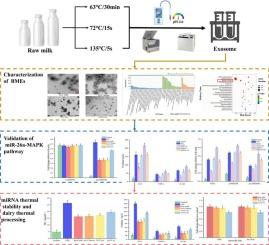Thermal stability of Milk-derived miRNAs guides graded processing strategies: Thermosensitive biomarker screening and p38 MAPK-mediated intestinal inflammatory regulation
IF 8
1区 农林科学
Q1 FOOD SCIENCE & TECHNOLOGY
引用次数: 0
Abstract
While thermal processing is essential for ensuring dairy product safety, the mechanisms by which it damages bovine milk exosomes (BMEs) components remain unclear and require elucidation. This study examined the thermal stability and anti-inflammatory regulatory mechanisms of BMEs miRNAs through gradient heat treatment (63 °C/30 min, 72 °C/15 s, 135 °C/5 s). Key findings: 1) UHT (135 °C/5 s) altered 419 miRNAs, with thermosensitive miR-26a decreasing by 18.25 % but retaining 97 % stability under HTST (72 °C/15 s), aligning with exosome structural thresholds. 2) Gene editing and dual-luciferase assays confirmed that miR-26a inhibits the MAPK pathway by targeting TAK1, with thermal degradation increasing p-p38 MAPK by >50 % compared to raw milk (P < 0.05). 3) Based onΔG, we propose a graded dairy processing strategy: high-ΔG miRNAs are suitable for non-thermal techniques, while medium-ΔG miRNAs tolerate HTST. This study links the “thermodynamic stability-inflammatory pathway regulation-process threshold response” of BMEs' miRNAs, providing molecular targets and regulatory pathways for the development of dairy products that precisely preserve functional activity.

乳源性mirna的热稳定性指导分级加工策略:热敏生物标志物筛选和p38 mapk介导的肠道炎症调节
虽然热处理对确保乳制品安全至关重要,但其损害牛奶外泌体(BMEs)成分的机制尚不清楚,需要阐明。本研究通过梯度热处理(63°C/30 min, 72°C/15 s, 135°C/5 s)研究了BMEs mirna的热稳定性和抗炎调节机制。主要发现:1)UHT(135°C/5 s)改变了419个mirna,其中热敏性miR-26a在HTST(72°C/15 s)下降低了18.25%,但保持了97%的稳定性,与外泌体结构阈值一致。2)基因编辑和双荧光素酶实验证实,miR-26a通过靶向TAK1抑制MAPK途径,与原料奶相比,热降解使P -p38 MAPK增加了50% (P < 0.05)。3)基于onΔG,我们提出了分级乳制品加工策略:高-ΔG mirna适合非热技术,而中等-ΔG mirna耐受高温高温。本研究将BMEs的mirna“热力学稳定性-炎症通路调节-过程阈值反应”联系起来,为开发精确保持功能活性的乳制品提供分子靶点和调控途径。
本文章由计算机程序翻译,如有差异,请以英文原文为准。
求助全文
约1分钟内获得全文
求助全文
来源期刊

Food Research International
工程技术-食品科技
CiteScore
12.50
自引率
7.40%
发文量
1183
审稿时长
79 days
期刊介绍:
Food Research International serves as a rapid dissemination platform for significant and impactful research in food science, technology, engineering, and nutrition. The journal focuses on publishing novel, high-quality, and high-impact review papers, original research papers, and letters to the editors across various disciplines in the science and technology of food. Additionally, it follows a policy of publishing special issues on topical and emergent subjects in food research or related areas. Selected, peer-reviewed papers from scientific meetings, workshops, and conferences on the science, technology, and engineering of foods are also featured in special issues.
 求助内容:
求助内容: 应助结果提醒方式:
应助结果提醒方式:


